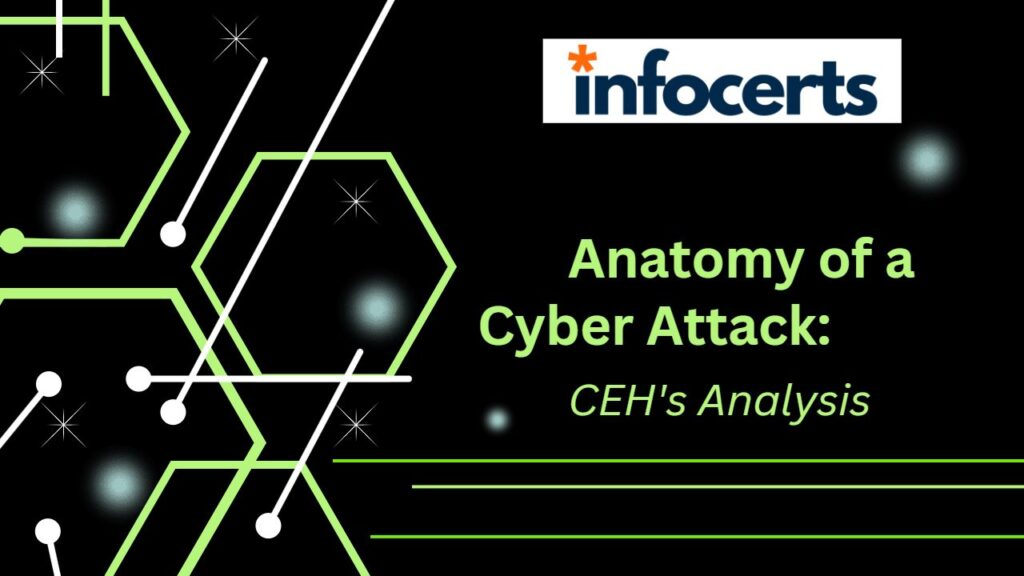Cyber attacks are a pervasive and growing threat to organizations and individuals alike. In order to better understand how cyber attacks work and how to defend against them, it’s helpful to take a closer look at the anatomy of a typical cyber attack. In this post, we’ll use the insights of Certified Ethical Hackers (CEHs) to analyze the various stages of a cyber attack.
- Reconnaissance
The first stage of a cyber attack is Reconnaissance, where the attacker gathers information about the target system or network. This can involve scanning for open ports, identifying vulnerable software or services, or researching potential vulnerabilities using publicly available information. CEHs use similar techniques to identify potential weaknesses in their clients’ networks so that they can be addressed before they can be exploited by attackers.
- Weaponization
Once the attacker has identified a vulnerability, the next stage is to develop a weaponized payload that can exploit it. This could involve writing custom Malware or using existing exploit kits that are widely available on the dark web. CEHs also use weaponized payloads in their testing, but only with the consent of their clients and in a controlled environment.
- Delivery
The weaponized payload needs to be delivered to the target system or network in order for the exploit to be successful. This can be done through various means, such as email phishing, social engineering, or exploiting other vulnerabilities. CEHs often use similar techniques in their testing to see if employees are susceptible to phishing attacks or other social engineering tactics.
- Exploitation
Once the weaponized payload has been successfully delivered, the attacker can Exploit the vulnerability and gain access to the target system or network. This could involve installing a backdoor, stealing data, or using the compromised system as a launchpad for further attacks. CEHs aim to discover these vulnerabilities before attackers do, so that they can be patched or mitigated.
- Installation
The attacker will often install additional software or tools on the compromised system in order to maintain access or expand their control. This could involve installing keyloggers, remote access tools, or other malware. CEHs use similar techniques to test whether their clients’ networks can detect or prevent such installations.
- Command and Control
The attacker needs to maintain communication with the compromised system in order to control it and extract data or perform further attacks. This involves setting up a Command and Control (C&C) channel, which can be hidden or encrypted to avoid detection. CEHs also use C&C channels in their testing to simulate realistic attack scenarios.
- Actions on Objectives
Finally, the attacker will carry out their ultimate objectives, which could include stealing data, destroying systems, or disrupting operations. CEHs simulate these objectives in their testing in order to identify potential weaknesses and recommend improvements.
| Stage of Cyberattack | Description | Example |
| Reconnaissance | Gather information about the target system or network | Scanning for open ports, researching potential vulnerabilities using publicly available information. |
| Weaponization | Develop a weaponized payload that can exploit the vulnerability | Writing custom malware, using existing exploit kits that are widely available on the dark web. |
| Delivery | Deliver the weaponized payload to the target system or network | Email phishing, social engineering, exploiting other vulnerabilities, physical access. |
| Exploitation | Exploit the vulnerability and gain access to the target system or network | Installing a backdoor, stealing data, using the compromised system as a launchpad for further attacks. |
| Installation | Install additional software or tools on the compromised system | Installing keyloggers, remote access tools, or other malware to maintain access or expand control. |
| Command and Control | Maintain communication with the compromised system | Setting up a command and control (C&C) channel, which can be hidden or encrypted to avoid detection. |
| Actions on Objectives | Carry out the ultimate objectives | Stealing sensitive data, destroying systems, disrupting operations, or extracting a ransom for restoring access. |
Conclusion: Cyber attacks are a serious threat to organizations and individuals. Understanding the different stages of a cyber attack is essential to better defend against them. Certified Ethical Hackers (CEHs) play a crucial role in identifying vulnerabilities and recommending best practices for mitigating the risk of cyber attacks.
FAQs:
- What is a cyber attack?
- What is CEH?
- How can I defend against cyber attacks?
——————————————————————————————————————–
Infocerts, 5B 306 Riverside Greens, Panvel, Raigad 410206 Maharashtra, India
Contact us – https://www.infocerts.com

